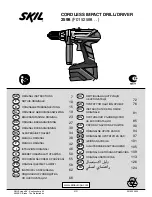
8
ENGLISH
High/low speed selector (fig. D and E)
The 2-speed feature of your drill allows for greater versatility.
X
To select the low speed, high torque setting (position 1),
turn the tool off and allow it to stop. Move the speed
selector switch (3) towards the back.
X
To select the high speed, low torque setting (position 2),
turn the tool off and allow it to stop. Move the speed
selector switch (3) towards the front.
Warning!
Do not move the speed selector button with the
tool switched on.
Keyless chuck (fig. E)
To insert a drill bit or other accessory:
X
Hold the chuck (1) and rotate it in a counter clockwise
direction, as viewed from the chuck end.
X
Insert the bit or other accessory fully into the chuck, and
tighten securely by rotating the chuck (1) in the
clockwise direction.
Warning!
Do not attempt to tighten drill bits (or any other
accessory) by gripping the chuck and turning the tool on or
damage to the chuck and personal injury may occur.
Driving screws
X
When driving screws, the forward/reverse button (4)
should be pushed to the left.
Move the forward/reverse button (4) pushed to the right for
removing screws.
Drilling
X
Use sharp drill bits only.
X
Support and secure the work properly.
X
Run the drill very slowly, using light pressure, until the
hole is started.
X
Apply pressure in a straight line with the bit. Use enough
pressure to keep the bit biting but not so much as to stall
the motor or deflect the bit.
X
Hold the drill firmly with two hands to control its twisting
action.
X
Do not click the trigger of a stalled drill on and off in an
attempt to start it. Damage to the drill can result.
X
Minimize stalling on breakthrough by reducing pressure
and drilling slowly through the last part of the hole.
X
Keep the motor running while pulling the bit out of a
drilled hole. This will help reduce jamming.
X
With variable speed drills there is no need to centre
punch the point to be drilled. Use a slow speed to start
the hole and accelerate by squeezing the trigger harder
when the hole is deep enough to drill without the bit
skipping out. Operate at full speed after starting the bit.
Drilling wood
Holes in wood can be made with the same twist drill bits used
for metal or with spade bits. These bits should be sharp and
should be pulled out frequently when drilling to clear chips
from the flutes of the drill.
Drilling in metal
Use a cutting lubricant when drilling metals. The exceptions
are cast iron and brass which should be drilled dry. The
cutting lubricants that work best are sulfurized cutting oil or
lard oil.
Drilling in masonry (VPX1222 only)
Use carbide tipped masonry bits. Refer to the section
“Drilling”. Keep an even force on the drill but not so much that
you crack the brittle material. A smooth, even flow of dust
indicates the proper drilling rate.
Maintenance
Your Black & Decker tool has been designed to operate over
a long period of time with a minimum of maintenance.
Continuous satisfactory operation depends upon proper tool
care and regular cleaning.
Your charger does not require any maintenance apart from
regular cleaning.
Warning!
Before performing any maintenance on the tool,
remove the battery from the tool. Unplug the charger before
cleaning it.
X
Regularly clean the ventilation slots in your tool and
charger using a soft brush or dry cloth.
X
Regularly clean the motor housing using a damp cloth.
Do not use any abrasive or solvent-based cleaner.
X
Regularly open the chuck and tap it to remove any dust
from the interior.
Protecting the environment
Separate collection. This product must not be
disposed of with normal household waste.
Should you find one day that your Black & Decker product
needs replacement, or if it is of no further use to you, do not
dispose of it with household waste. Make this product
available for separate collection.
Separate collection of used products and packaging
allows materials to be recycled and used again. Re-
use of recycled materials helps prevent
environmental pollution and reduces the demand
for raw materials.
Local regulations may provide for separate collection of
electrical products from the household, at municipal waste
sites or by the retailer when you purchase a new product.









































